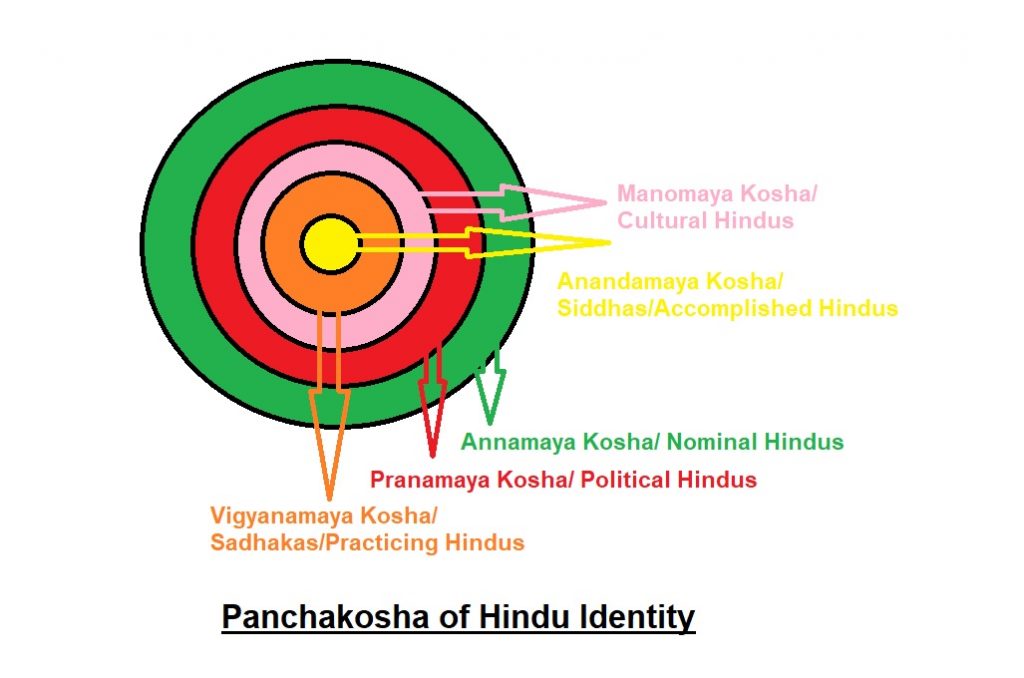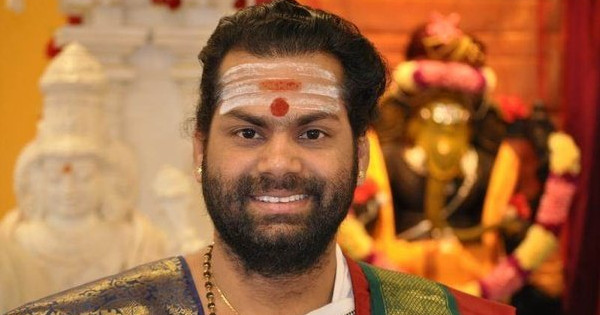Recently, while interacting with the students of Arya Mahila College affiliated to Banaras Hindu University, Varanasi, I was asked, ‘What makes someone a Hindu?’ As I paused for a few moments to reflect on this complicated question, I realized there is a beautiful framework available within our own knowledge tradition that can be utilized to provide a comprehensive perspective on Hindu identity.
Complex Nature of Hindu Identity
A few years ago when I met Sankrant Sanu, the entrepreneur, researcher, and the author of an important book, ‘The English Medium Myth’, we got into a discussion about comparative religions and how Hinduism is different from Abrahamic religions.
On that occasion, when I quoted Dr. Radhakrishnan about Hinduism being a way of life, Sankrant remarked that the argument that Hinduism is unique because it is a way of life is incorrect since almost all major religions of the world, be it Christianity or Islam, for example, have full-fledged ways of life of their own. That remark made me revisit the statement of the learned philosopher and I realized that his exact quote[i] already contains the answers to the above objection, as if anticipating it!
While it is true that all major religions across the world have full-fledged ways of life, there is a fundamental difference between the Abrahamic worldview and the Hindu worldview.
Belief in One God, One Book, and the Prophet is the core of their way of life. It is this belief that takes one to heaven, while disbelievers are fated to suffer in hell. Thus, their way of life is driven by belief. Belief is the defining trait of ‘religion’, a word which is most suitably applied to Abrahamic monotheistic communities like Christianity and Islam.
Sanatana Dharma, on the other hand, “enjoins a strict code of practice” while allowing “absolute liberty in the world of thought”. It is not that faith or belief plays no role in Hinduism. Shraddha, which can be roughly translated as faith or trust (though these English words do not really do justice to the source terminology), does indeed have an important place in the Hindu scheme of things. But, it is not the end in itself. Its position is more akin to as a gateway for practice. Moreover, Hinduism has no concept of permanent heaven or hell which one obtains based on whether a person believes or disbelieves. Instead, our concept of life is rooted in the understanding that the Jivatma, or the individual, who assumes various bodies based on its previous actions, and likewise attains temporary states of happiness or suffering called Svarga and Naraka respectively, based on whether it has performed virtuous or non-virtuous actions.
Therefore, Hinduism which is indeed a way of life, is one where ‘the way of Dharma’ is stressed, and one which is meant to be practised, not merely and notionally believed in.
However, this definition raises its own sets of problems. If Hinduism is a way of life meant to be practised, does it mean that all Hindus are by default practising Hindus? A perusal of even a small sample of Hindus will show that this is hardly the case. There are those Hindus who happily claim that they are not ‘Hindus’. There are also those who profess their belief in the religion of ‘secularism’. Then, there are those who are politically own up Hindu identity, but hardly have any affinity for culture or tradition. There are those who practise Hindu traditions and those who claim nominal acceptance of the identity.
This being the case, how do we understand the complex nature of Hindu identity? In this article, I try to provide a framework for understanding our identity, based on the Vedantic framework of ‘Panchakosha’.
Vedantic framework of Panchakosha
While the modern scientific view, that is largely rooted in materialism, perceives an individual (Jiva) as just a body, Vedanta Darshana posits the Jiva as a complex multi-layered being, which on the one hand is a reflection of Brahman, the supreme divine reality, and on the other hand, is endowed with Pancha Koshas – five sheaths or layers of individuality through which it interacts with the external universe.
The outermost sheath is the physical body called as ‘Annamaya Kosha’. Subtler than this is the sheath of life-forces called ‘Pranamaya Kosha’. This is made up of the five Pranas –Prana, Apana, Udana, Samana, and Vyana – which together facilitate various bodily activities such as breathing, circulation, excretion, etc. Subtler than this is the sheath of the mind called ‘Manomaya Kosha’, and even more subtle is the sheath of the intellect called ‘Vigyanamaya Kosha’. The innermost and the most subtle sheath is the sheath of bliss called ‘Anandamaya Kosha’.
Panchakosha of Hindu Identity
Let us now use this Vedantic model and build a Panchakosha framework of identity for Hindu society. Let us imagine Hindu society as being made up of five concentric sheaths with each concentric sheath representing a particular section of Hindu society that share certain specific values, ideologies, and worldview.
Corresponding to the Annamaya Kosha is the outermost concentric sheath which represents the most tangible (visible), but least substantial manifestation of Hindu identity: people who have Hindu parentage and are legally Hindu but with zero or very less affinity and allegiance to Hindu identity. I like to call this section of Hindu society as ‘Nominal Hindus’ who, as the name denotes, are Hindus only in name. They have neither any affinity to Hindu culture and traditions, nor do they have any concern for the political struggles of Hindu society. Often, they profess allegiance to ‘religion of secularism and liberalism’ and look down upon their own ancestral traditions and practices.
Moving inwards and towards a more substantial sheath of Hindu identity, we have the ‘Political Hindus’ who correspond to the Pranamaya Kosha. These are people who identify themselves as Hindu at a socio-economic-political sphere of life. They are politically aware but have zero or nominal affinity to religious, cultural or philosophical aspects of Hindu civilization. Many of them could even be atheists, rationalists, or nominal theists who look down upon Hindu traditions and practices with the same jaundiced perspective as the Nominal Hindus. Their concern and focus is in fighting the political enemies of Hindu society including the radical Islamist and evangelical menace in Hindu society. There are many such political Hindus even at an academic level, who while working for Hindu identity and expression at socio-political level, have zero affinity to cultural aspects, at times even looking down upon them!
Moving further inward, we have the sheath of ‘Cultural Hindus’ who are more substantial in their Hindu identity. They correspond to the Manomaya Kosha, and have a great affinity to the cultural practices of Hindu civilization. They may or may not be politically aware. They may or may not be religious practitioners. They could even be atheists. But, they have great love for and affinity to cultural practices and traditions, be it the celebration of festivals, or visiting temples and Kshetrams, or the traditions of art, music, and dance.

Moving even more inward, corresponding to the Vigyanamaya Kosha, we have the ‘Practising Hindus’ or ‘Sadhakas’. They are practitioners of Sanatana Dharma. They observe and celebrate the rituals, arts, Shastras, music, dance, festivals, and other aspects of Sanatana Dharma. They recognize their life as being a Sadhana / spiritual effort, and seek to attain the purusharthas through everything they do in life. They are those who dedicate their lives to the preservation of Veda, those who immerse themselves in the study and interpretation of Shastras, those who make the art forms – be it classical dance, music, painting, or sculpture – their spiritual sadhana to reach the ultimate, and those who perform rituals for themselves and for others. In short, practising Hindus are those who accept the Hindu philosophical and religious worldview, who have Shraddha in the Hindu Shastras being the pramana (means) for valid knowledge, who try to live according to precepts of the Shastras, and who involve themselves in Sadhana in one way or the other. Shraddha, Svadhaya, Sadhana, and Sadachara are the four pillars of life for the practising Hindu.
Finally, those corresponding to the innermost sheath, the Anandamaya Kosha, are the ‘Siddhas’ or ‘Accomplished Hindus’. These are masters who have perfected their Sadhanas. These are the Gurus, Yogis, Acaryas, Rishis, and Paramahamsas, who have perfected their lives, who have attained their goals walking on the path of Dharma and Sadhana, and who are the role models and teachers for the rest of the society. Thus, Hindu identity can be conceived of as having five concentric sheaths: Nominal, Political, Cultural, Practising, and Accomplished. However, I would like to add one more term here: ‘Civilizational Hindu’. Irrespective of a person’s position in this ‘Panchakosha of Identity’, we can consider him/her as a Civilizational Hindu as long as s/he is aware and appreciates the complexity of Hindu civilization with its different sheaths and facets, each having its own needs and importance.
[i] Dr. S Radhakrishnan in The Hindu View of Life: “Hinduism is more a way of life than a form of thought. While it gives absolute liberty in the world of thought, it enjoins a strict code of practice….The performer of the good and not the believer in this or that view – can never get into an evil state. In a very real sense, practice precedes theory. Only by doing the will does one know the doctrine…Hinduism insists on a moral life and draws into fellowship all who feel themselves bound to the claims which the moral law makes upon them. Hinduism is not a sect but a fellowship of all who accept the law of right and earnestly seek for the truth.”
Featured Image: worldnewsdailyreport.com
Disclaimer: The opinions expressed in this article are the personal opinions of the author. IndiaFacts does not assume any responsibility or liability for the accuracy, completeness, suitability, or validity of any information in this article.
Nithin Sridhar has a degree in Civil Engineering, and having worked in the construction field, he passionately writes about various issues from development, politics, and social issues, to religion, spirituality, and ecology. He is currently Editor of IndiaFacts- a portal on Indian history and culture; He is editor of Advaita Academy dedicated to the dissemination of Advaita Vedanta. He is a Consulting Editor to Indic Today Magazine. He is based in Mysuru, Karnataka. His first book “Musings On Hinduism” provided an overview of various aspects of Hindu philosophy and society. His latest book ‘Samanya Dharma’ enunciates upon general tenets of ethics as available in Hindu texts. However, his most widely read book is “Menstruation Across Cultures: A Historical Perspective” that examines menstruation notions and practices prevalent in different cultures & religions from across the world. He tweets at @nkgrock.

